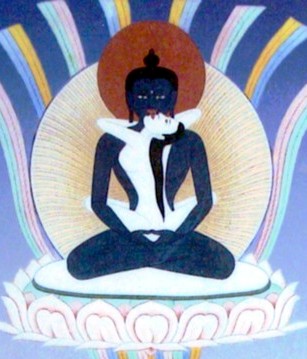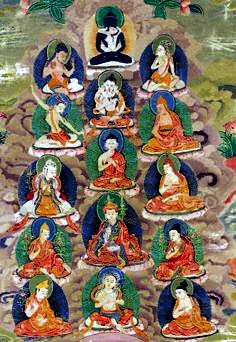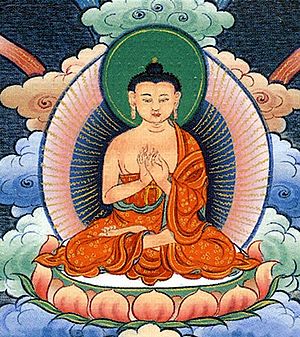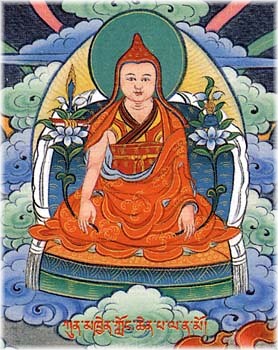Dzogchen

Dzogchen or Dzogpachenpo (Skt. Mahāsaṅdhi or Atiyoga; Tib. རྫོགས་པ་ཆེན་པོ་, Wyl. rdzogs pa chen po) — the ‘Great Perfection’, or ‘Great Completeness’. The practice of Dzogchen is the most ancient and direct stream of wisdom within the Buddhist tradition of Tibet. Sogyal Rinpoche describes it as "the heart-essence of all spiritual paths and the summit of an individual’s spiritual evolution"[1]. As a way in which to realize the innermost nature of mind—that which we really are—Dzogchen is the clearest, most effective, and most relevant to the modern world.
What is Dzogchen?
Dzogchen is both the final and ultimate teaching, and the heart of the teachings of all the Buddhas. Though generally associated with the Nyingma or Ancient School of Tibetan Buddhism founded by Padmasambhava, Dzogchen has been practised throughout the centuries by masters of all the different schools as their innermost practice. Its origins reach back to before human history, and neither is it limited to Buddhism, nor to Tibet, nor indeed even to this world of ours, as it is recorded that it has existed in thirteen different world systems.
Dzogchen is an abbreviation of the Tibetan word Dzogpachenpo. ‘Dzogpa’ means ‘complete’, or ‘the end’; ‘chenpo’ means ‘great’. It is widely translated as “Great Perfection”, but this may imply a perfection that we strive to attain, a journey towards a goal of Great Perfection, and this is not the meaning of Dzogchen. Dzogchen is explained as Ground, Path and Fruition, and from the point of view of the Ground of Dzogpachenpo, it is the already self-perfected state of our primordial nature, which needs no ‘perfecting’, for it has always been perfect from the very beginning, just like the sky. It is uncreated, yet spontaneously accomplished.
Traditionally ‘Dzogchen’ can be traced to two original Sanskrit terms. The first is Mahasandhi, which means the Great (mahā) Gathering (sandhi), but here refers to the gathering of all or the quintessence, signifying that Dzogchen is the very essence, the cream and the heart juice of all teachings. Hence many of the teachings are known as ‘Nyingtik’ or ‘Heart Essence’, for example the Longchen Nyingtik.
The second term is Atiyoga, which means highest (ati) yoga (union, from _/yuj, to yoke, unite). This term is said to be a back-translation and is not attested in the literature (see Trungpa’s term Mahā-ati below). Ati indicates the topmost, summit or zenith. It has the sense of scaling a mountain, reaching the peak and having a view over everything. For Atiyoga or Dzogchen stands at the apex of the characteristic Nyingmapa presentation of the Buddhist path as Nine Yanas or vehicles, with the three Inner Tantras special to the Nyingma tradition: Mahayoga, Anuyoga and Atiyoga. The zenith of all yanas, Atiyoga represents the culmination of an individual’s spiritual evolution, the point where all spiritual disciplines and paths have been traversed. The term ‘Maha Ati’ has also been used for Dzogchen in recent times by masters like Chögyam Trungpa Rinpoche.
Lineage

The lineage of Dzogchen is traced from the Dharmakaya Samantabhadra to the Sambhogakaya—the five buddha families and Vajrasattva, who are Samantabhadra’s own self-reflection. This is the Mind Direct Transmission (Tib. Gyalwa Gong Gyü). Vajrasattva appeared to the first human master Garab Dorje, who was born in Oddiyana, empowered him, and instructed him to write down the Dzogchen Tantras. The transmission then passed to Mañjushrimitra, Shri Singha and Jñanasutra through the Sign Transmission of the Vidyadharas (Tib. Rigdzin Da Gyü), and was continued in Tibet by Padmasambhava, Vimalamitra and Vairotsana. From Padmasambhava onwards is counted as the Oral Transmission (Tib. Gangzak Nyen Gyü). (See Three lineages of transmission)
The Dzogchen Teachings

The ultimate source of the teachings of Atiyoga or Dzogchen is the Primordial Buddha Samantabhadra. Whilst the root of Dzogchen is the 6,400,000 verses or shlokas, the actual tantras are said to number 22,000. Dzogchen can be categorized into gyü, lung and mengak. Gyü is the tantras, lung (Skt. agama) the clarification of the tantras, and mengak (Skt. upadesha) the experiential instruction given by the master.
The Three Categories
The 6,400,000 verses of the Dzogchen tantras were divided by Mañjushrimitra into three categories or series:
- the category of mind (Semdé),
- the category of space (Longdé), and
- the category of Secret or Pith Instruction (Mengakdé).
Shri Singha further divided the Mengakdé into four cycles: outer, inner, secret and innermost, unexcelled. The core of the Mengakdé are the teachings of Nyingtik, ‘Heart Essence’, and amongst the most important Nyingtik cycles are the Vima Nyingtik, taught in Tibet by Vimalamitra; the Khandro Nyingtik, taught in Tibet by Padmasambhava; and the Longchen Nyingtik, the essence of the Dzogchen teachings of the great master Longchenpa, revealed by Jikmé Lingpa. Many practitioners of Nyingtik in Tibet attained the rainbow body. The Semdé and Longdé were transmitted in Tibet mainly by Vairochana and Vimalamitra, and the Mengakdé by Vimalamitra and Padmasambhava. The three categories are taught to suit the capacities or disposition (kham) of individual students. For example, for someone who is more intellectually inclined or analytical, there is the teaching of Semdé, and for a person who is drawn more to nature and inclined towards simplicity, there is Longdé.
The teachings which place more emphasis on the natural condition of the mind (sem kyi né luk), were classed by Mañjushrimitra as Semdé, the category of mind. There are twenty-one main tantras of Semdé, exemplified by the Kunjé Gyalpo. Five were translated into Tibetan by Vairotsana, and thirteen translated later by Vimalamitra, Nyak Jñanakumara and Yudra Nyingpo. Longdé teachings are characterized as those that emphasize ‘freedom from effort’. Chief amongst the tantras of Longdé is the Longchen Rabjam Gyalpo. In Mengakdé, which is superior to both Semdé and Longdé, there are many texts, mainly the Seventeen Tantras of the Innermost Unexcelled Cycle in the Nyingma Gyübum; principal amongst these is the root tantra, the Reverberation of Sound Tantra (Tib. Dra Thal Gyur).
Trekchö and Tögal
In Mengakdé, there are two paths of training: Trekchö and Tögal. Trekchö is translated as ‘thoroughly cutting through’ (resistance, stubbornness, toughness and closedness), or ‘breakthrough’. The practice of Trekchö reveals the View of kadak trödral. Tögal, translated as ‘direct crossing’, ‘the direct approach’ or ‘leapover’, can bring very quickly the actual realization of the three kayas in this lifetime, and thus is a more rapid way of bringing about the dissolution of the practitioner’s karmic vision. The practice of Tögal brings the realization of lhündrup, ‘spontaneous presence’, and it can only be undertaken by a practitioner who has first gained stability in the practice of Kadak Trekchö. There is a saying: ‘Trekchö trek ma chö na, tögal tö mi gal’, which means: “if the practice of Trekchö is not accomplished, then the Tögal can not transcend.” The Ground in Dzogchen therefore, is the indivisibility of ‘kadak’, primordial purity and ‘lhündrup’, spontaneous presence. The Path is the practice of Trekchö, through which kadak is realized, and Tögal, through which lhündrup is realized. The Fruition is to attain the Buddha body (ku) and wisdom (yeshé).
The Dzogchen Path

Dilgo Khyentse Rinpoche outlines the whole path of Dzogchen:
- “The practice of Dzogchen or Atiyoga, is to realise the tathagatagarbha, or buddha nature, which has been present in our nature since the very beginning. Here it is not sufficient to concentrate on contrived practices that involve intellectual efforts and concepts; to recognise this Nature, the practice should be utterly beyond fabrication. The practice is simply to realise the radiance, the natural expression of wisdom, which is beyond all intellectual concepts. It is the true realisation of the Absolute Nature just as it is, the ultimate fruition.
- At the present moment our awareness is entangled within our mind, completely enveloped and obscured by mental activity. Through the practice of Trekchö, or ‘cutting through all attachment’, and the ‘direct realization’ of Tögal, one can unmask this awareness and let its radiance arise.
- To accomplish this it is necessary to do the practice of ‘the four ways of leaving things in their natural simplicity’ (Tib. chokshyak shyi) and through these, to acquire perfect stability in the Trekchö practice. Then will come the ‘four visions of tögal’ which are the natural arising of visions of discs and rays of light, deities and buddha fields. These visions are naturally ready to arise from within the central channel that joins the heart to the eyes. Such an arising from this channel will appear in a gradual process. In the same way that the waxing moon will increase from the first to the fifteenth of the month, these visions will gradually increase—from the simple perception of dots of light to the full array of the vast expanse of the sambhogakaya buddha fields. The manifestation of space and awareness will thus reach its culminating point.
- These experiences are not linked with consciousness or intellect as the former experiences were; they are a true manifestation or radiance of awareness. After this, in the same way that the moon decreases and disappears from the fifteenth to the thirtieth of the month, all of these experiences and visions, all phenomena, will gradually come to exhaustion and reabsorb themselves in the Absolute. At this time the deluded mind which conceives subject and object will disappear, and the primal wisdom, which is beyond intellect, will gradually expand. Eventually one will attain the perfect enlightenment of the Primordial Buddha, Samantabhadra, endowed with the six extraordinary features.
- This is the path intended for people of superior faculties who can achieve enlightenment in this very lifetime. For those of medium faculties, there is instruction on how to achieve liberation within the 'Bardo' or ‘intermediate state’. When we say ‘Bardo’, in fact we recognise four bardos: the Bardo from conception to death; the Bardo of the moment of death; the Bardo of the Absolute Nature; and the Bardo of coming into the next existence.
- The Bardo between conception and death is our present state. In order to destroy all deluded perceptions or deluded thoughts in this Bardo, the ultimate practice is Dzogchen Atiyoga. In this there are the two main paths of Trekchö and Tögal, as described above. As the ultimate fruition of this practice, the ordinary body made of gross aggregates will dissolve into the ‘Rainbow Body of Great Transference’ or ‘Vajra-body’, or dissolve without leaving any remnants.
- But if one cannot achieve such ultimate attainment within a lifetime, then there is still the possibility of achieving enlightenment at the time of death. If our teacher or a close Dharma brother is near to us at the very moment of our death, he will remind us of the instructions—the introduction to the nature of mind. If we can recall our experience of practice and remain in this nature, then we achieve realization. It is then possible to depart to a buddha field straightaway with no intermediate state. If this is not accomplished, then the Bardo of the Absolute Nature, or Dharmata, will arise. At this time the Ground Luminosity of the Dharmakaya will appear. If one can unite the Ground Luminosity (Mother Luminosity) with the Luminosity which one has recognized whilst practising during one’s lifetime (Child Luminosity), then one will be liberated into the Dharmakaya.
- If one is not liberated at this time, then countless manifestations will appear: sounds, lights and rays. Great fear will arise because of these emanations and visions, but if one is a good practitioner one will realize that there is no point in being afraid. One will know that whatever deities appear, wrathful or peaceful, they are one’s own projections. The recognition of this assures liberation in a sambhogakaya buddha field. But if this is not accomplished, then the Bardo of coming into a new existence will occur. If one practises in the right way at this time one can be liberated into a nirmanakaya buddha field.
- In essence, the primordial nature of the Buddha Samantabhadra is like the ground or mother-nature of realization. The nature which has been introduced to us by the teacher is like the child-nature. When these two meet, one will attain full realization and seize the fortress of Enlightenment.
- For ordinary beings unable to achieve liberation either in this life or in the intermediate state, liberation can be attained in the nirmanakaya buddha fields.
- In brief, through the practice of the path of Trekchö and Tögal, one will reach the ultimate realization of the Dharmakaya, the enlightened state of the Primordial Buddha Samantabhadra, within this very lifetime. This is the best case. If not, then one can be freed in the other three Bardos: the Bardos of the moment of death, Dharmata and Becoming. Even if this does not happen, one can still be relieved of suffering and be liberated by the virtues or blessings of the Dzogchen teachings. Whoever has a connection with these teachings is: liberated by sight, on seeing the teaching or the teacher; liberated through hearing, on hearing the teacher or teaching; liberated through contact, on wearing the precious mantras and scriptures of Dzogchen; or liberated through taste, and so forth. As a result, one will be liberated into one of the five nirmanakaya buddha fields.”[2]
Notes
- ↑ Sogyal Rinpoche, The Tibetan Book of Living and Dying, page 155.
- ↑ From a teaching on the Longchen Nyingtik Guru Yoga, given by Kyabje Dilgo Khyentse Rinpoche in Dordogne, France in August 1984, at the request of Sogyal Rinpoche and the Rigpa Sangha
Teachings on the Meaning of 'Dzogchen' Given to the Rigpa Sangha
- Sogyal Rinpoche, Haileybury, UK, 6 April 2010
Teachings on the Lineage of Dzogchen Given to the Rigpa Sangha
- Orgyen Tobgyal Rinpoche, Lerab Ling, 24 September 2014
Further Reading
- Marcia Binder Schmidt (compiled and edited by), The Dzogchen Primer—Embracing the Spiritual Path According to the Great Perfection (Shambhala Publications, 2002)
- The Dalai Lama, Dzogchen: Heart Essence of the Great Perfection (Snow Lion, 2004)
- The Dalai Lama, Mind in Comfort and Ease: The Vision of Enlightenment in the Great Perfection (Wisdom Publications, 2007)
- Nyoshul Khenpo, A Marvelous Garland of Rare Gems: Biographies of Masters of Awareness in the Dzogchen Lineage, translated by Richard Barron (Junction City: Padma Publishing, 2005)
- Adam Pearcey (translated and introduced by), Patrul Rinpoche, Jamgön Mipham, & others, Beyond the Ordinary Mind: Dzogchen, Rimé, and the Path of Perfect Wisdom (Snow Lion Publications, 2018)
- Sogyal Rinpoche, Dzogchen and Padmasambhava (Rigpa Fellowship, 1989)
- Sogyal Rinpoche, The Nine Yanas, ‘Dzogchen Atiyoga‘ (Zam, 2004), pages 16-25.
- Sogyal Rinpoche, The Tibetan Book of Living and Dying (HarperSanFrancisco, Revised and Updated, 2002), pages 155-56.
- Tulku Thondup, The Practice of Dzogchen: Longchen Rabjam's Writings on the Great Perfection, Revised and Expanded Edition (Boston & London: Snow Lion, 2014)
- Sam van Schaik, Approaching the Great Perfection: Simultaneous and Gradual Methods of Dzogchen Practice in the Longchen Nyingtig (Boston: Wisdom Publications, 2003)